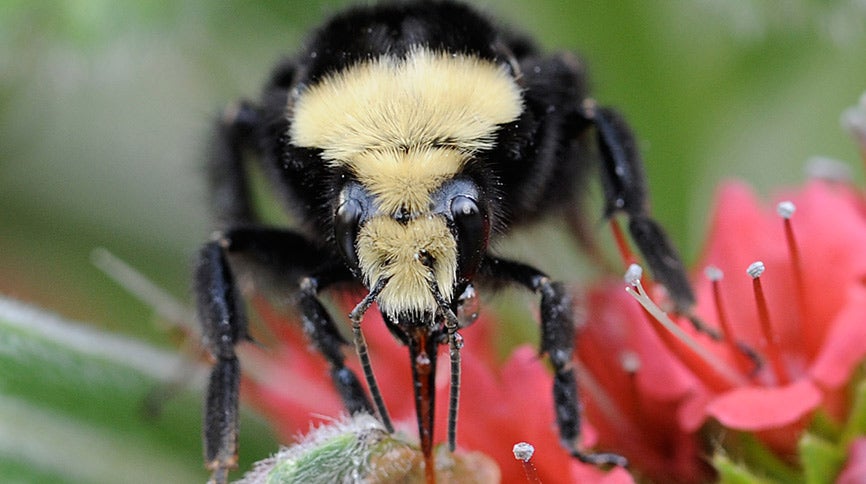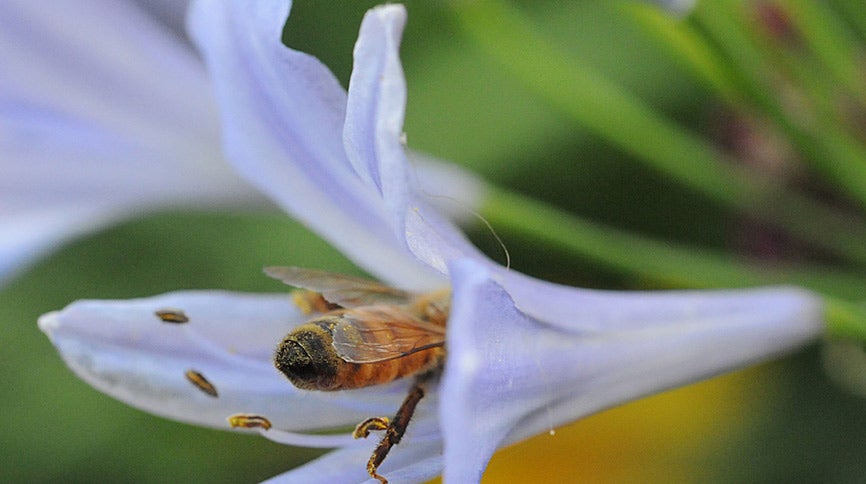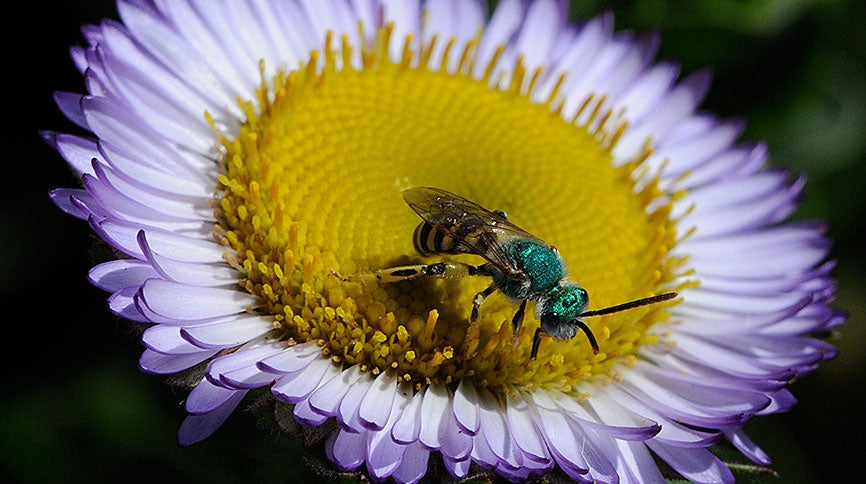It’s easy to have nurturing thoughts about honey bees. They get a lot of attention for producing honey and pollinating flowers. But what about bumblebees — or bees you never heard of: blue orchard bees, sweat bees and small carpenter bees. Do they matter?
Facts about pollinators
- 35 percent of primary food crops benefit from animal pollinators
- Global value of pollination: More than $220 billion annually
- In the US, honeybees account for $14.6 billion, wild bees account for more than $3 billion
You know the answer: Of course, they matter. Domesticated pollinators (a.k.a. honey bees) and wild foragers (bumblebees and others) are essential to our food supply. Bees pollinate about a third of all the food we eat, including most of the fruits, nuts and vegetables that make our diets tasty and nutritious. Wildlife also benefit, because bees pollinate wild plants that provide food and habitat.
Worldwide, wild bees make about the same economic contribution in crop pollination as managed bee colonies, according to a study from Wageningen University in the Netherlands. The study also found that 80 percent of that pollination came from just 2 percent of wild bee species.
UC Davis has devoted itself to the health of bees through much of our history, including developing techniques to artificially inseminate queen bees in the 1940s. Our program, based at the Harry H. Laidlaw Jr. Honey Bee Research Facility, has has grown into a comprehensive, state- and federally supported bee facility.
Our researchers focus on basic bee biology and genetics. That work aims to address international concerns about bee health and meet the needs of California’s multibillion-dollar agricultural industry.
Faculty like Neal Williams and Rachel Vannette in the Department of Entomology and Nematology are working to reverse the trend of dwindling bee populations. Some of the research — which includes work by our undergraduate engineering students — is pretty ingenious. Let me offer three stories.
Figuring out how best to weigh a bee

UC Davis entomologists and an interdisciplinary team of undergraduate engineering students are working on a new tool to weigh bumblebees that far surpasses the conventional lab balance.
The entomologists want to understand the health of the hive down to the individual bee, and that includes knowing how much individual bees weigh, as well as fitting them with tiny radio-frequency identification (RFID) chips so that single bees can be tracked entering and leaving the hive.
If the engineers can make the instrument sufficiently sensitive, they can measure how much pollen each bee brings back from a foraging trip. (Bumblebees weigh between 150 and 200 milligrams, and a typical pollen load is about 1 percent of that.)
“So they were faced with a problem: How to weigh a tiny, jittery insect that will only stand on a scale for fractions of a second. It was time to call in some engineers,” writes Andy Fell of Strategic Communications.
First, electrical engineering students solved the problem of taking the raw signal from the scale and obtaining time-stamped data for individual bees. Then the mechanical engineering students were asked to design and build a functional mechanism for the entomologists while providing the electrical engineering team with a useable data stream.
Weighing bees at these micro-milligram levels will help entomologists understand what effect changes in resources — such as when acreage covered in nectar-laden wild flowers converts to agriculture — have on bumblebees in both the short and long term. The ultimate goal is to help preserve our declining populations of wild bees.
Honeybees reduce microbial growth in their food

Vannette and a team of UC Davis entomologists came up with a bee finding I didn’t expect, dealing with how bees protect themselves from toxins and microogranisms.
The UC Davis scientists found that when honeybees shift from nurse bees (caring for the brood) to foragers searching for nectar and pollen, they turn on a set of genes that protect against microorganisms and break down toxins.
“First, the results suggest that forager bees may use antimicrobial peptides — short sequences of amino acids with general activity — to reduce microbial growth in stored food resources,” says Vannette.
These antimicrobials and antitoxins act as preservatives, protecting honey and other stored resources from spoilage. That has implications for hive health and management.
This type of work on the honeybee immune system could help us understand the causes and consequences of diseases or syndromes such as colony collapse disorder.
More high-demand crops means fewer wild bees

A study by UC Davis and the University of Vermont suggests that wild bee populations likely declined in 23 percent of the nation between 2008 and 2013. It’s a decline associated with converting natural wild bee habitat into intensive agriculture.
Williams helped design the study and led efforts to assess bee habitat quality as part of the Integrated Crop Pollination Project. He found that areas where crop demand has increased the most showed the greatest decline in wild pollinators. And that includes bumblebees, which have a documented decline in population over the past few decades beyond this study.
“Our mapped index of bee abundance clearly shows that areas of intense agriculture (e.g. the Midwest Corn Belt and California’s Central Valley) are among the lowest in predicted wild bee abundance,” Williams says.
The study followed a 2014 U.S. presidential memorandum calling for a national assessment of pollinators to promote the health of honeybees and other pollinators. The federal strategy calls for setting aside 7 million acres over a five-year period for domestic and wild bees.
How you can learn more about bees
Follow UC Davis’ blog, The Bee Gardener, to get the latest about bees, bee health and how you might help nurture honey bees and their wild siblings.
If you are traveling near UC Davis, take a guided tour of our Häagen-Dazs Honey Bee Haven. The garden is open year-round during daylight hours for self-guided tours, and admission is free. With five or more people, you can request a tour from one of our staff.
Susanne Rockwell, a longtime campus communicator and alumna, is web editor for the UC Davis homesite.